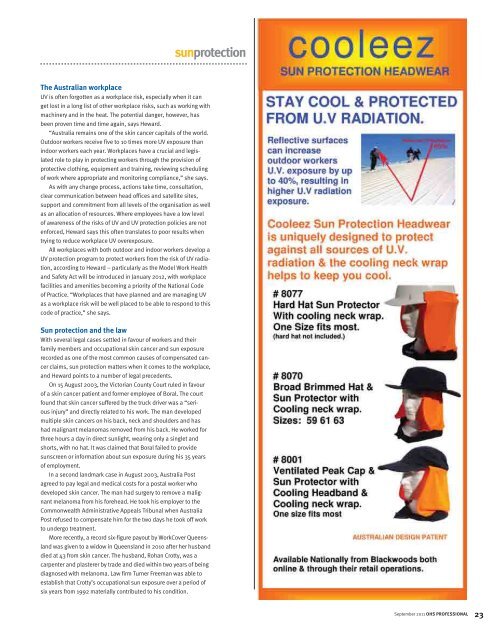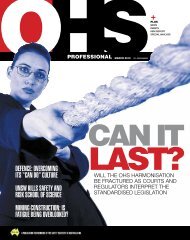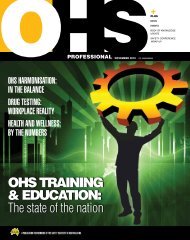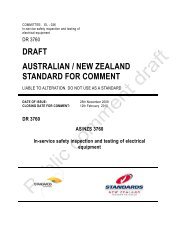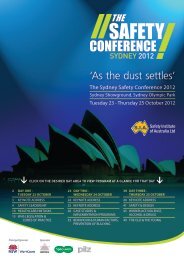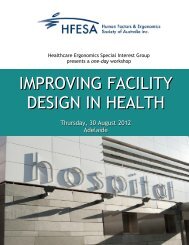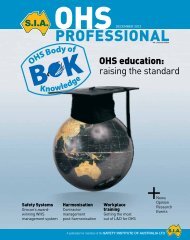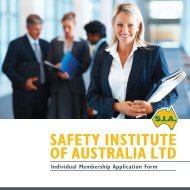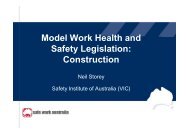Workplace bullying - Safety Institute of Australia
Workplace bullying - Safety Institute of Australia
Workplace bullying - Safety Institute of Australia
Create successful ePaper yourself
Turn your PDF publications into a flip-book with our unique Google optimized e-Paper software.
sunprotection<br />
The <strong>Australia</strong>n workplace<br />
UV is <strong>of</strong>ten forgotten as a workplace risk, especially when it can<br />
get lost in a long list <strong>of</strong> other workplace risks, such as working with<br />
machinery and in the heat. The potential danger, however, has<br />
been proven time and time again, says Heward.<br />
“<strong>Australia</strong> remains one <strong>of</strong> the skin cancer capitals <strong>of</strong> the world.<br />
Outdoor workers receive five to 10 times more UV exposure than<br />
indoor workers each year. <strong>Workplace</strong>s have a crucial and legislated<br />
role to play in protecting workers through the provision <strong>of</strong><br />
protective clothing, equipment and training, reviewing scheduling<br />
<strong>of</strong> work where appropriate and monitoring compliance,” she says.<br />
As with any change process, actions take time, consultation,<br />
clear communication between head <strong>of</strong>fices and satellite sites,<br />
support and commitment from all levels <strong>of</strong> the organisation as well<br />
as an allocation <strong>of</strong> resources. Where employees have a low level<br />
<strong>of</strong> awareness <strong>of</strong> the risks <strong>of</strong> UV and UV protection policies are not<br />
enforced, Heward says this <strong>of</strong>ten translates to poor results when<br />
trying to reduce workplace UV overexposure.<br />
All workplaces with both outdoor and indoor workers develop a<br />
UV protection program to protect workers from the risk <strong>of</strong> UV radiation,<br />
according to Heward – particularly as the Model Work Health<br />
and <strong>Safety</strong> Act will be introduced in January 2012, with workplace<br />
facilities and amenities becoming a priority <strong>of</strong> the National Code<br />
<strong>of</strong> Practice. “<strong>Workplace</strong>s that have planned and are managing UV<br />
as a workplace risk will be well placed to be able to respond to this<br />
code <strong>of</strong> practice,” she says.<br />
Sun protection and the law<br />
With several legal cases settled in favour <strong>of</strong> workers and their<br />
family members and occupational skin cancer and sun exposure<br />
recorded as one <strong>of</strong> the most common causes <strong>of</strong> compensated cancer<br />
claims, sun protection matters when it comes to the workplace,<br />
and Heward points to a number <strong>of</strong> legal precedents.<br />
On 15 August 2003, the Victorian County Court ruled in favour<br />
<strong>of</strong> a skin cancer patient and former employee <strong>of</strong> Boral. The court<br />
found that skin cancer suffered by the truck driver was a “serious<br />
injury” and directly related to his work. The man developed<br />
multiple skin cancers on his back, neck and shoulders and has<br />
had malignant melanomas removed from his back. He worked for<br />
three hours a day in direct sunlight, wearing only a singlet and<br />
shorts, with no hat. It was claimed that Boral failed to provide<br />
sunscreen or information about sun exposure during his 35 years<br />
<strong>of</strong> employment.<br />
In a second landmark case in August 2003, <strong>Australia</strong> Post<br />
agreed to pay legal and medical costs for a postal worker who<br />
developed skin cancer. The man had surgery to remove a malignant<br />
melanoma from his forehead. He took his employer to the<br />
Commonwealth Administrative Appeals Tribunal when <strong>Australia</strong><br />
Post refused to compensate him for the two days he took <strong>of</strong>f work<br />
to undergo treatment.<br />
More recently, a record six-figure payout by WorkCover Queensland<br />
was given to a widow in Queensland in 2010 after her husband<br />
died at 43 from skin cancer. The husband, Rohan Crotty, was a<br />
carpenter and plasterer by trade and died within two years <strong>of</strong> being<br />
diagnosed with melanoma. Law firm Turner Freeman was able to<br />
establish that Crotty’s occupational sun exposure over a period <strong>of</strong><br />
six years from 1992 materially contributed to his condition.<br />
September 2011 OHS PROFESSIONAL 23


